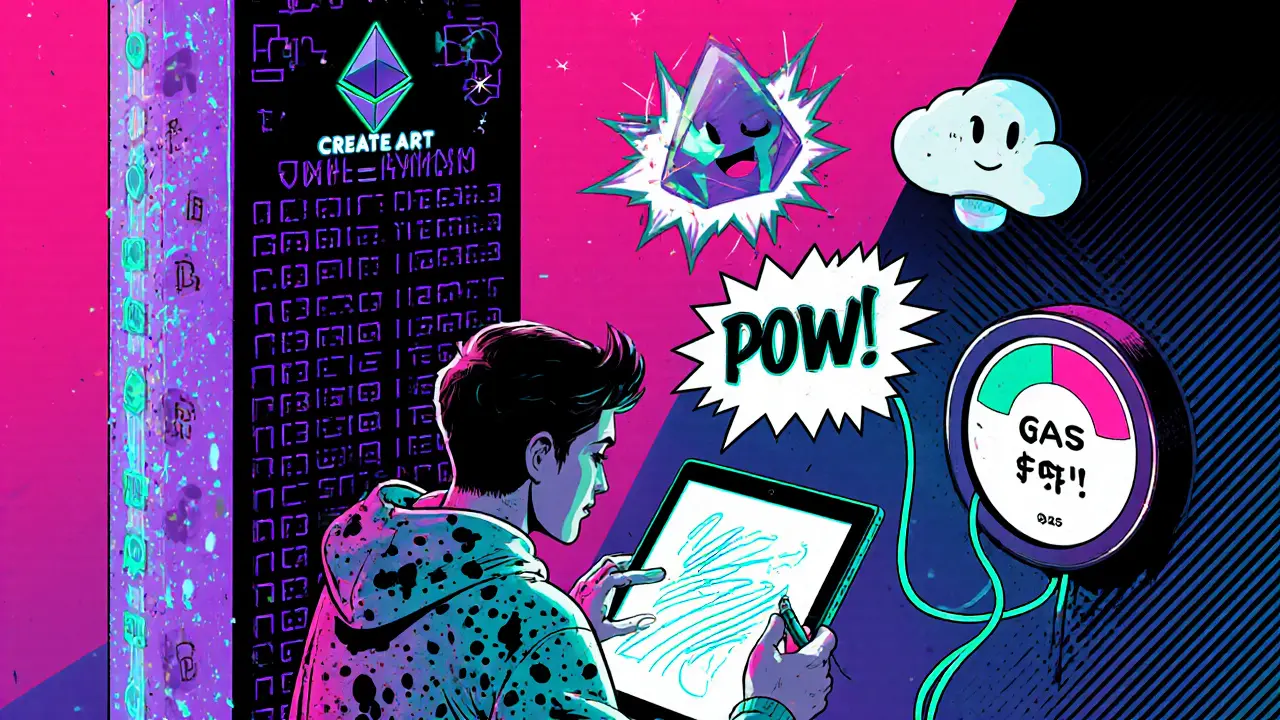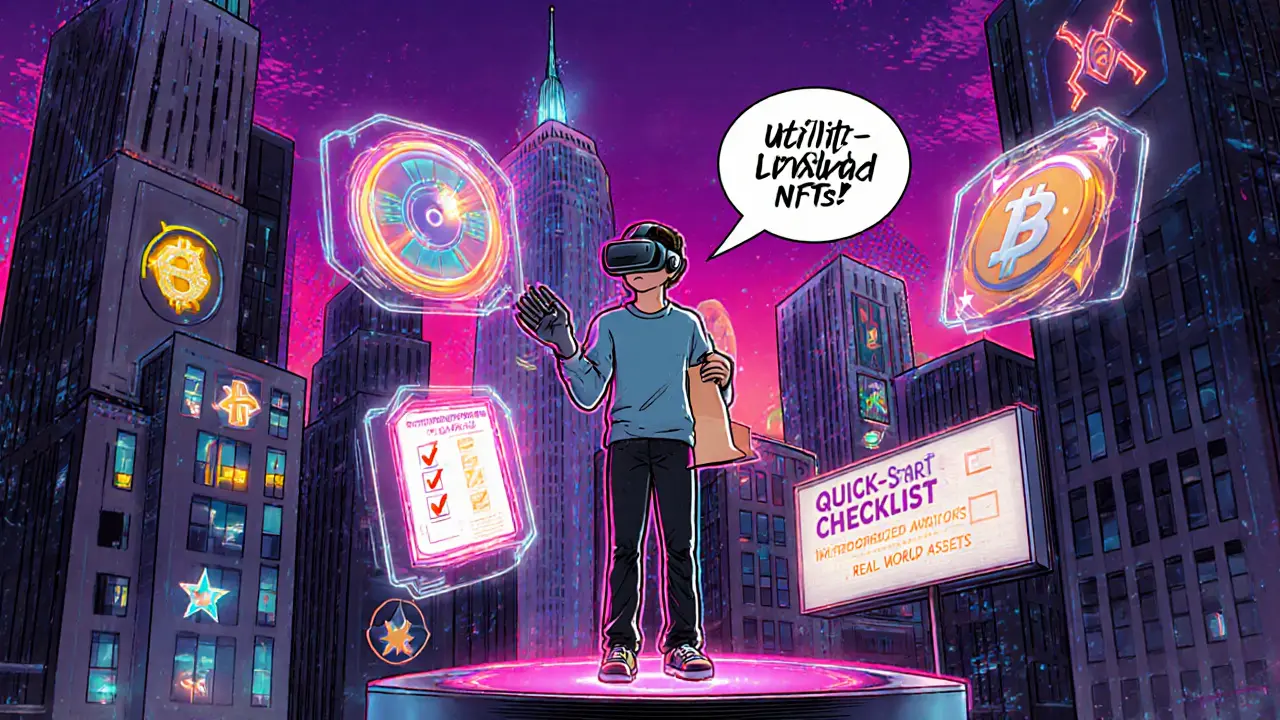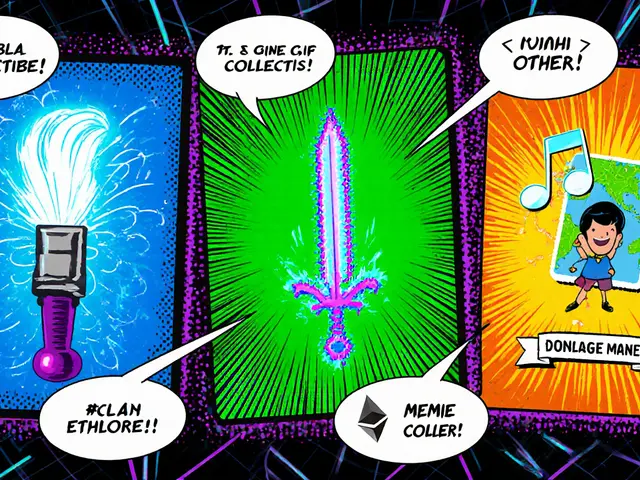NFT Collectible Category Explorer
Select a category below to learn more about its characteristics, typical content, popular platforms, and why collectors are interested in these NFTs.
Art Collectibles
Digital paintings, generative art, animated GIFs
Game Collectibles
Skins, weapons, virtual land, avatars
Hybrid / Other
Sports cards, music tracks, memes, domain names
Quick Facts
- NFTs are unique crypto‑tokens that prove ownership of a digital item.
- The technology behind them lives on public blockchains like Ethereum.
- Beeple’s $69.3million sale in 2021 put NFT art on everybody’s radar.
- Minting turns a file into a token, attaching a hash and a smart‑contract record.
- Markets now host art, gaming skins, virtual cards and even tokenised real‑world assets.
When you hear the phrase NFT digital art collectibles, you’re hearing a shorthand for a whole ecosystem that blends art, code and finance. Below we break down what the term really means, how the tech works, where you can find these assets, and what risks to watch out for.
What Exactly Is an NFT Digital Art Collectible?
NFT digital art collectible is a non‑fungible token that represents a unique piece of digital artwork or a collectible item stored on a blockchain. Unlike Bitcoin or Ether, which are interchangeable, each token carries its own identifier and cannot be split into smaller units.
The “non‑fungible” part simply means that no two tokens are exactly alike - think of them as digital certificates of authenticity, much like a signed print or a limited‑edition trading card.
How Do They Work? The Technical Backbone
At the core of every NFT digital art collectible are three technical components:
- Blockchain ledger - a public, immutable record of every transaction.
- Smart contract - code that defines the token’s rules (creation, transfer, royalties).
- Metadata storage - usually a link to the actual artwork kept on a decentralized system.
When an artist mints an NFT, the file (image, video, audio) is first hashed - a cryptographic fingerprint that guarantees the file hasn’t been altered. The hash, together with a token name, symbol and a pointer to the file, is written into a smart contract on a blockchain such as Ethereum the most widely used network for NFT creation and trading. Most creators store the large media files on IPFS the InterPlanetary File System, a peer‑to‑peer storage protocol that makes the file resilient to censorship. The blockchain then serves as a permanent log that anyone can verify, similar to a property deed.
Key Players and Platforms
Several entities have become synonymous with NFT art:
- Beeple digital artist whose "Everydays: The First 5000 Days" sold for $69.3million in 2021, sparking mainstream interest.
- Panini traditional trading‑card company that now runs a blockchain marketplace for sports and entertainment NFTs.
- OpenSea, Rarible, SuperRare - marketplaces where creators list and collectors browse.
These platforms bundle the minting tools, smart‑contract templates, and community features (forums, Discord servers) that make buying and selling easier for non‑technical users.

Categories of NFT Digital Art Collectibles
Not every NFT is a painted picture. The market clusters into three broad groups, each with its own collector culture:
| Category | Typical Content | Key Platforms | Collector Motivation |
|---|---|---|---|
| Art Collectibles | Digital paintings, generative art, animated GIFs | SuperRare, Foundation, MakersPlace | Support artists, own a unique visual piece |
| Game Collectibles | Skins, weapons, virtual land, avatars | Axie Infinity, Decentraland, Fortnite (future) | In‑game utility, status, play‑to‑earn earnings |
| Hybrid / Other | Sports cards, music tracks, memes, domain names | Panini, NBA Top Shot, OpenSea | Nostalgia, royalty earnings, brand affiliation |
How to Mint, Buy, and Store an NFT
Getting started only takes a few steps, but each step has a security angle you shouldn’t overlook.
- Set up a crypto wallet. Most NFTs live on Ethereum, so a wallet like MetaMask, Trust Wallet, or Coinbase Wallet will hold both Ether (for gas fees) and the token itself.
- Fund the wallet. Purchase a modest amount of Ether from an exchange; even a transaction can cost $5‑$30 in gas depending on network congestion.
- Choose a marketplace. Connect your wallet to OpenSea, Rarible, or a niche platform that matches your interest (e.g., Panini for sports cards).
- Mint (if you’re the creator). Upload the artwork, let the platform generate the hash, and confirm the smart‑contract creation. You’ll pay a one‑time minting fee.
- Buy or bid. For collectors, you can either purchase at a fixed price or place a bid in an auction. Once the transaction confirms, the NFT shows up in your wallet’s crypto art section of the wallet, where you can view the token’s metadata and provenance.
- Secure your asset. Enable two‑factor authentication on your wallet, back up the seed phrase offline, and consider a hardware wallet for high‑value pieces.
Valuation, Market Dynamics, and Risks
Prices of NFT digital art collectibles are driven by the same forces that move any collectible market: scarcity, demand, creator reputation, and cultural relevance. A single Beeple piece sold for $69.3million, yet most daily transactions hover in the $100‑$5,000 range.
Because the blockchain records every sale, you can check an NFT’s entire price history before you buy. However, keep these warnings in mind:
- Speculation. Many buyers hope to flip an asset for a profit, which can inflate prices artificially.
- Liquidity. Not every token finds a buyer quickly; niche art or obscure gaming skins can sit unsold for months.
- Ownership ambiguity. Owning an NFT usually means you own a token that points to the artwork, not the copyright or reproduction rights.
- Scams and fraud. Fake marketplaces, plagiarised art, and rug pulls still happen. Verify the creator’s profile and community reputation.
- Environmental concerns. Proof‑of‑work blockchains consume significant energy, though many platforms are shifting to proof‑of‑stake to lower the carbon footprint.
Future Outlook: Beyond Pure Collectibles
While the hype cycle has ebbed since the 2021 peak, the underlying technology is maturing. Expect three trends to shape the next wave:
- Utility‑linked NFTs. Tokens that grant access to virtual events, unlock in‑game features, or act as membership passes.
- Tokenised physical assets. Companies like Panini are experimenting with NFTs that certify ownership of real‑world cards, sneakers, or even real estate.
- Interoperable metaverses. As virtual worlds converge, NFTs could act as portable avatars or digital fashion items across multiple platforms.
Regulators are also catching up. In the UK and EU, guidelines around consumer protection and AML (anti‑money‑laundering) are being drafted, which may add compliance steps for marketplaces but also bring more legitimacy.
Quick‑Start Checklist for New Collectors
- Install a reputable crypto wallet and back up the seed phrase.
- Buy a small amount of Ether to cover gas fees.
- Research the creator’s social presence and previous sales.
- Start with a modest purchase on a well‑known marketplace.
- Enable two‑factor authentication and consider a hardware wallet for high‑value NFTs.

Frequently Asked Questions
Do I own the artwork when I buy an NFT?
You own the token that proves provenance and ownership on the blockchain. The underlying copyright usually stays with the creator unless explicitly transferred.
Can I sell an NFT I bought on a different platform?
Yes. Since the token lives on a public blockchain, you can list it on any marketplace that supports the same token standard (usually ERC‑721 or ERC‑1155).
What is the difference between ERC‑721 and ERC‑1155?
ERC‑721 creates a single, unique token per contract - ideal for one‑of‑a‑kind art. ERC‑1155 can batch multiple tokens (both fungible and non‑fungible) in one contract, which is useful for game items and series of collectibles.
How much does it cost to mint an NFT?
Minting fees vary by blockchain congestion. On Ethereum you might pay $20‑$100 in gas, while layer‑2 solutions like Polygon can reduce that to a few dollars.
Are NFTs a good investment?
They can appreciate, but they’re also highly speculative. Treat them as a hobby or a way to support creators, not a guaranteed financial vehicle.

